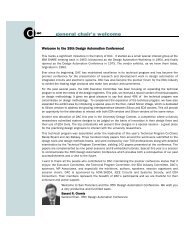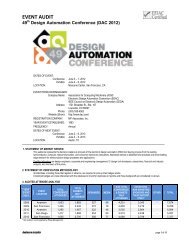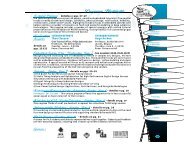Power Gate Optimization Method for In-Rush Current and Power Up ...
Power Gate Optimization Method for In-Rush Current and Power Up ...
Power Gate Optimization Method for In-Rush Current and Power Up ...
You also want an ePaper? Increase the reach of your titles
YUMPU automatically turns print PDFs into web optimized ePapers that Google loves.
<strong>Power</strong> <strong>Gate</strong> <strong>Optimization</strong><br />
<strong>Method</strong> <strong>for</strong> <strong>In</strong>-<strong>Rush</strong> <strong>Current</strong><br />
<strong>and</strong> <strong>Power</strong> <strong>Up</strong> Time<br />
Presenter : Teng, Siong Kiong<br />
Ung, Chee Kong<br />
<strong>In</strong>tel Corporation<br />
<strong>In</strong>tel <strong>and</strong> the <strong>In</strong>tel logo are registered trademarks of <strong>In</strong>tel Corporation or its subsidiaries in the United States <strong>and</strong> other<br />
countries. Other names <strong>and</strong> br<strong>and</strong>s may be claimed as the property of others. All products, dates, <strong>and</strong> figures are<br />
preliminary <strong>and</strong> are subject to change without any notice. Copyright © 2011, <strong>In</strong>tel Corporation.
Disclaimers<br />
The flow results discussed have been simulated <strong>and</strong> are provided <strong>for</strong> in<strong>for</strong>mational purposes only. Results were derived<br />
using EDA software tool that run on an <strong>In</strong>tel’s VLSI design. Any difference in VLSI design or software tool or<br />
configuration or flow may affect actual results.<br />
No computer system can provide absolute security under all conditions. <strong>In</strong>tel® Trusted Execution Technology (<strong>In</strong>tel®<br />
TXT) requires a computer system with <strong>In</strong>tel® Virtualization Technology, an <strong>In</strong>tel TXT-enabled processor, chipset, BIOS,<br />
Authenticated Code Modules <strong>and</strong> an <strong>In</strong>tel TXT-compatible measured launched environment (MLE). The MLE could<br />
consist of a virtual machine monitor, an OS or an application. <strong>In</strong> addition, <strong>In</strong>tel TXT requires the system to contain a<br />
TPM v1.2, as defined by the Trusted Computing Group <strong>and</strong> specific software <strong>for</strong> some uses. For more in<strong>for</strong>mation, see<br />
http://www.intel.com/technology/security.<br />
<strong>In</strong>tel <strong>and</strong> the <strong>In</strong>tel logo is a trademark or registered trademark of <strong>In</strong>tel Corporation or its subsidiaries in the United States<br />
<strong>and</strong> other countries.<br />
Per<strong>for</strong>mance tests <strong>and</strong> ratings are measured using specific computer systems <strong>and</strong>/or components <strong>and</strong> reflect the<br />
approximate per<strong>for</strong>mance of products as measured by those tests. Any difference in system hardware or software<br />
design or configuration may affect actual per<strong>for</strong>mance.<br />
<strong>In</strong>tel does not control or audit the design or implementation of third party benchmark data or Web sites referenced in<br />
this document. <strong>In</strong>tel encourages all of its customers to visit the referenced Web sites or others where similar<br />
per<strong>for</strong>mance benchmark data are reported <strong>and</strong> confirm whether the referenced benchmark data are accurate <strong>and</strong> reflect<br />
per<strong>for</strong>mance of systems available <strong>for</strong> purchase.<br />
*Other names <strong>and</strong> br<strong>and</strong>s may be claimed as the property of others.
<strong>Power</strong> Gating <strong>for</strong> Leakage Reduction<br />
Post 90nm technology SOC low power dominated by sub-threshold<br />
leakage.<br />
Decreasing the length of transistors from transistor scaling reduces the<br />
depletion channel length <strong>and</strong> hence increases the leakage current.<br />
Sub-threshold leakage current also increases with temperature at each<br />
process node hence created a compounding effect.<br />
<strong>Power</strong> Gating using MOS devices to <strong>for</strong>m a switch between an external<br />
<strong>and</strong> internal power network is a well known <strong>and</strong> very effective technique<br />
to control leakages of logic gates.<br />
To pkg, pcb, battery<br />
Header Cell<br />
(PMOS)<br />
<strong>Gate</strong>d Vdd<br />
3
<strong>Power</strong> <strong>Gate</strong>d Implementation<br />
Ungated <strong>Power</strong><br />
gated <strong>Power</strong><br />
Place <strong>and</strong> Route tool is used to pre-place the PFETs<br />
PFET is segmented into smaller PFETs distributed<br />
across whole power gated domain.<br />
PFETs are stitched <strong>and</strong> connected in serial to<br />
reduce in-rush current during power up.<br />
4
<strong>Power</strong> <strong>Up</strong> Window <strong>and</strong> <strong>In</strong>-<strong>Rush</strong> <strong>Current</strong><br />
Ungated <strong>Power</strong><br />
gated <strong>Power</strong><br />
Iin-rush Ishort circuit<br />
vcc
No<br />
<strong>In</strong>-<strong>Rush</strong> <strong>Current</strong> <strong>Optimization</strong> <strong>Power</strong> <strong>Up</strong><br />
Analysis Flow<br />
Met <strong>Power</strong><br />
<strong>Up</strong> Time<br />
Auto Place & Route<br />
PFET Stitching<br />
PFET Removal Algo<br />
<strong>Power</strong> <strong>Up</strong> Analysis<br />
Yes Yes<br />
IR-Drop Verification<br />
Met IR Drop<br />
Yes<br />
Done<br />
Met <strong>In</strong>-<strong>Rush</strong><br />
<strong>Current</strong><br />
No<br />
No<br />
After Place <strong>and</strong> Route,<br />
the PFET Stitching flow<br />
is used to optimize the<br />
stitching direction.<br />
PFET removal algorithm<br />
is applied to improve the<br />
in-rush current.<br />
<strong>Power</strong> <strong>Up</strong> Analysis is<br />
done to collect the <strong>In</strong>-<br />
<strong>Rush</strong> current profile <strong>and</strong><br />
voltage ramp up time.<br />
IR-Drop Verification to<br />
verify no IR drop issue.<br />
6
PFET Stitching Flow<br />
Last<br />
PFET<br />
1 st<br />
PFET<br />
1 way stitching method <strong>for</strong> PFET’s control. Only 1<br />
chain is used.<br />
7
PFET Stitching<br />
Last<br />
PFET<br />
1 st<br />
PFET<br />
P (2) ways stitching method <strong>for</strong> PFET’s control.<br />
Total PFET chain Delay = N x T<br />
Where N = total number of PFET<br />
T = single PFET stage delay<br />
Number of PFET ways P = N x T / Treq<br />
Where Treq = <strong>Power</strong> <strong>Up</strong> Time Requirement 8<br />
1 st<br />
PFET<br />
Last<br />
PFET
PFET Removal Algorithm<br />
Removal Cost Higher Removal Cost Lower<br />
Receiver<br />
Driver<br />
Prior publication by LK Yong <strong>and</strong> etc used <strong>Power</strong> Perimeter Scan (PPS) to<br />
scans <strong>for</strong> power gate load at its given perimeter / window <strong>and</strong> remove the<br />
PFETs located in the overlapping windows.<br />
We use the driver-receiver pair list that had high short circuit power with PPS to<br />
determine if the PFET can be removed.<br />
PFETs close to the receiver region will get higher cost function <strong>for</strong> removal.<br />
PFETs close to the driver region will get lower cost function <strong>for</strong> removal.<br />
9
Results<br />
Description<br />
Peak <strong>In</strong>-<br />
<strong>Rush</strong><br />
<strong>Current</strong><br />
(mA)<br />
<strong>Power</strong><br />
<strong>Up</strong> Time<br />
(ns)<br />
Max IR<br />
Drop<br />
(mV)<br />
Driver-<br />
Receiver<br />
Pair<br />
Violations<br />
1 way stitching 156 15.5 25 633<br />
2 way stitching 279 7 25 255<br />
1 way stitching with<br />
PFET removal<br />
2 ways stitching with<br />
PFET removal<br />
85 37 28 274<br />
219 11 26 102<br />
2 way stitching algorithm improves the power up time but increase the<br />
in-rush current.<br />
The PFETs removal algorithm is proven to be able to reduce the inrush<br />
current .<br />
The max IR drop is kept within the 30mV budget specification range.<br />
10
Summary<br />
The in-rush current during power up event is ascribed<br />
by both leakage <strong>and</strong> short-circuit current.<br />
Our proposal is able to reduce the in-rush current due<br />
to short-circuit current by clever avoidance on the<br />
voltage difference on drivers <strong>and</strong> receivers pair<br />
circuitry.<br />
The PFET stitching flow is also addressing the power<br />
up time concerns to reduce the power up time.<br />
Both the approaches are done without creating further<br />
IR Drop issue.<br />
The power up time <strong>and</strong> in rush current are affecting<br />
each other at the opposite way, the power grid<br />
designers will need to make the proper tradeoff to<br />
ensure the power gated design are meeting the<br />
product specified goal.<br />
11










